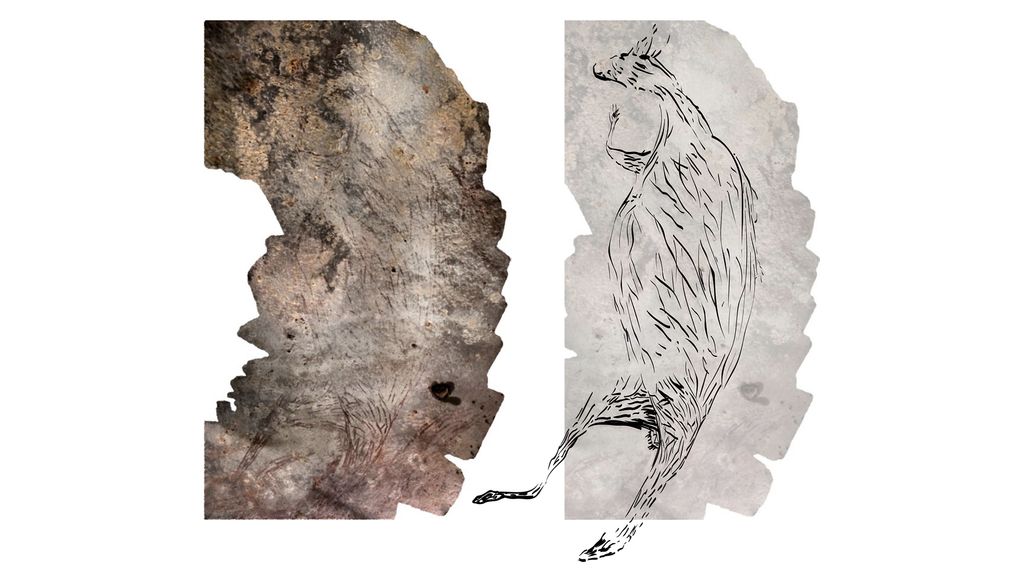Welcome to DU!
The truly grassroots left-of-center political community where regular people, not algorithms, drive the discussions and set the standards.
Join the community:
Create a free account
Support DU (and get rid of ads!):
Become a Star Member
Latest Breaking News
Editorials & Other Articles
General Discussion
The DU Lounge
All Forums
Issue Forums
Culture Forums
Alliance Forums
Region Forums
Support Forums
Help & Search
Anthropology
Related: About this forumAustralia's oldest rock painting is an anatomically accurate kangaroo
By Mindy Weisberger - Senior Writer 14 hours ago
An unusual dating method revealed the painting's age.

A montage of 39 photographs of the 17,300 year old kangaroo, next to an illustration of the painting. (Image credit: Peter Veth, Balanggarra Aboriginal Corporation/Illustration: Pauline Heaney and Damien Finch)
A nearly-life-size depiction of a kangaroo — realistic genitalia included — is the oldest known rock painting in Australia. Scientists recently pinpointed its age to 17,300 years ago with a technique that had never been used on Australian ancient art before: measuring radioactive carbon in wasp nests from rocks near the artwork.
The kangaroo painting extends across the ceiling of a rock shelter and spans nearly 7 feet (2 meters), which is roughly the height of a modern kangaroo. This and other paintings in northwestern Australia's Kimberley region share certain stylistic features with the earliest cave art from Europe and Asia, the researchers reported. Very old animal paintings such as these are typically life-size (or close to it); they represent anatomy in a similar way, and their outlines are only partly filled-in with sketched lines. Because of these features, the paintings were thought to be among Australia's oldest.
However, to precisely date such art, scientists often turn to radiocarbon dating, which measures the ratio of different versions, or isotopes, of carbon in an object. But it requires organic material, which is scarce in rock paintings.
In places such as the Chauvet Cave in France, ancient drawings are etched in charcoal and hidden deep inside limestone caverns, preserving the organic matter in the charcoal pigments and making radiocarbon dating possible. Chauvet art has been directly dated to between 34,000 and 29,000 years ago, the study authors wrote.
More:
https://www.livescience.com/kangaroo-art-australia-oldest.html
InfoView thread info, including edit history
TrashPut this thread in your Trash Can (My DU » Trash Can)
BookmarkAdd this thread to your Bookmarks (My DU » Bookmarks)
1 replies, 1071 views
ShareGet links to this post and/or share on social media
AlertAlert this post for a rule violation
PowersThere are no powers you can use on this post
EditCannot edit other people's posts
ReplyReply to this post
EditCannot edit other people's posts
Rec (3)
ReplyReply to this post
1 replies
 = new reply since forum marked as read
Highlight:
NoneDon't highlight anything
5 newestHighlight 5 most recent replies
= new reply since forum marked as read
Highlight:
NoneDon't highlight anything
5 newestHighlight 5 most recent replies
Australia's oldest rock painting is an anatomically accurate kangaroo (Original Post)
Judi Lynn
Feb 2021
OP
Kid Berwyn
(18,049 posts)1. Surprised it's survived the Oz mining interests.
Rio Tinto blasts 46,000-year-old Aboriginal site to expand iron ore mine
Mining company was given permission to blast Juukan Gorge cave, which provided a 4,000-year-old genetic link to present-day traditional owners
Calla Wahlquist
The Guardian, May 26, 2020
A sacred site in Western Australia that showed 46,000 years of continual occupation and provided a 4,000-year-old genetic link to present-day traditional owners has been destroyed in the expansion of an iron ore mine.
The cave in Juukan Gorge in the Hammersley Ranges, about 60km from Mt Tom Price, is one of the oldest in the western Pilbara region and the only inland site in Australia to show signs of continual human occupation through the last Ice Age. It was blasted along with another sacred site on Sunday.
Mining company Rio Tinto received ministerial consent to destroy or damage the site in 2013 under WA’s outdated Aboriginal heritage laws, which were drafted in 1972 to favour mining proponents.
One year after consent was granted, an archeological dig intended to salvage whatever could be saved discovered the site was more than twice as old as previously thought and rich in artefacts, including sacred objects.
Most precious was a 4,000-year-old length of plaited human hair, woven together from strands from the heads of several different people, which DNA testing revealed were the direct ancestors of Puutu Kunti Kurrama and Pinikura traditional owners living today.
Continues...
https://www.theguardian.com/australia-news/2020/may/26/rio-tinto-blasts-46000-year-old-aboriginal-site-to-expand-iron-ore-mine
Mining company was given permission to blast Juukan Gorge cave, which provided a 4,000-year-old genetic link to present-day traditional owners
Calla Wahlquist
The Guardian, May 26, 2020
A sacred site in Western Australia that showed 46,000 years of continual occupation and provided a 4,000-year-old genetic link to present-day traditional owners has been destroyed in the expansion of an iron ore mine.
The cave in Juukan Gorge in the Hammersley Ranges, about 60km from Mt Tom Price, is one of the oldest in the western Pilbara region and the only inland site in Australia to show signs of continual human occupation through the last Ice Age. It was blasted along with another sacred site on Sunday.
Mining company Rio Tinto received ministerial consent to destroy or damage the site in 2013 under WA’s outdated Aboriginal heritage laws, which were drafted in 1972 to favour mining proponents.
One year after consent was granted, an archeological dig intended to salvage whatever could be saved discovered the site was more than twice as old as previously thought and rich in artefacts, including sacred objects.
Most precious was a 4,000-year-old length of plaited human hair, woven together from strands from the heads of several different people, which DNA testing revealed were the direct ancestors of Puutu Kunti Kurrama and Pinikura traditional owners living today.
Continues...
https://www.theguardian.com/australia-news/2020/may/26/rio-tinto-blasts-46000-year-old-aboriginal-site-to-expand-iron-ore-mine